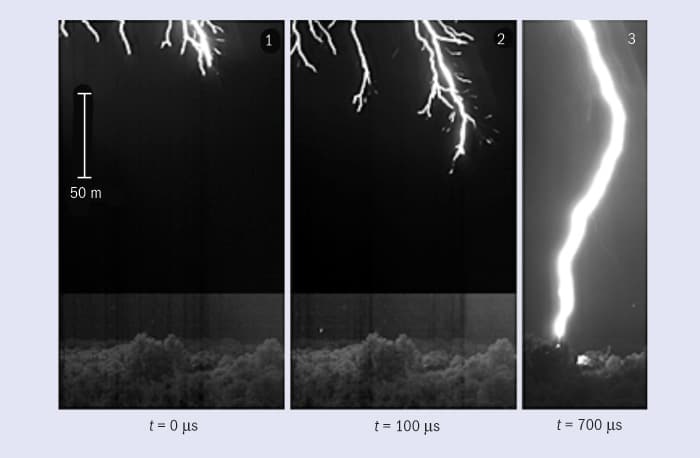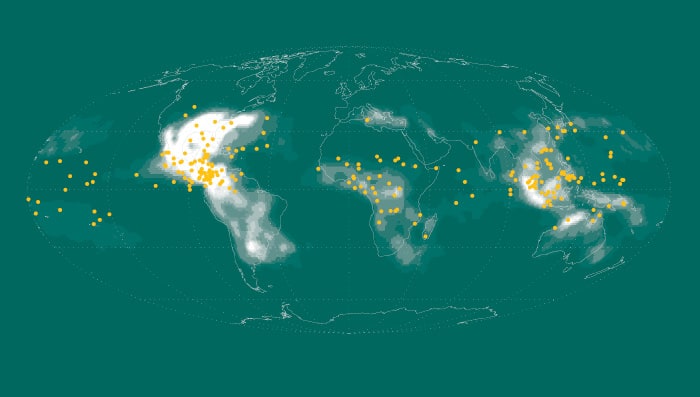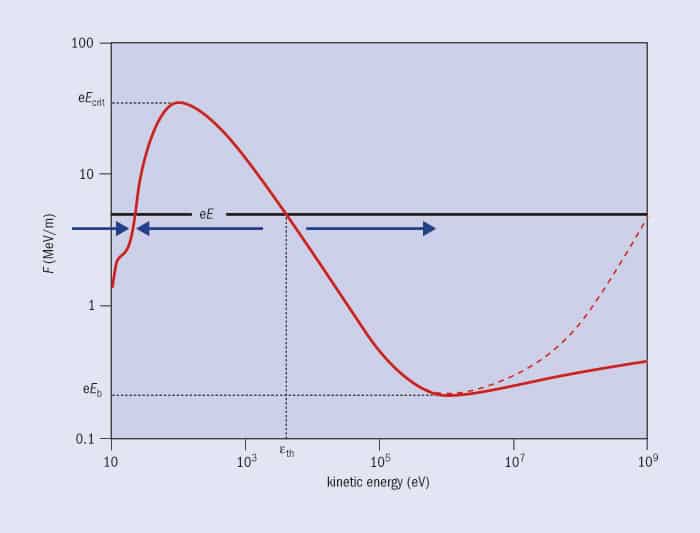Casper Rutjes and Ute Ebert trace how our understanding of thunderstorm physics has evolved in recent decades and explain how neutron measurements could produce fresh insights

The link between thunderstorm and neutron science is not an obvious one. Indeed, it took a Nobel laureate to spot it. By the time he made the connection, Willard Libby was already a highly regarded scientist thanks to his profound work on radiocarbon dating. This method – which became a standard tool for archaeologists, and earned Libby the Nobel Prize for Chemistry in 1960 – stemmed from the observation that when cosmic rays impinge on the Earth’s atmosphere, they produce a shower of particles, including neutrons. These neutrons can react with atmospheric nitrogen to create carbon-14, or radiocarbon (n + 147N → 146C + p), which enters the food chain when plants absorb the resulting radioactive carbon dioxide. Libby’s insight was to realize that in living organisms, carbon-14 is constantly refreshed together with other carbon isotopes. However, when an animal or plant dies, the ratio of radiocarbon to the stable isotopes carbon-12 and carbon-13 decays with a half-life of 5730 years – making it possible to estimate the age of objects made from formerly living matter with a high degree of accuracy.
By 1973, decades had passed since Libby published this Nobel-winning work, and he was entering the autumn of his career. He was still thinking about neutrons, though, and as he was examining tree rings with a colleague, H R Lukens, the pair noticed interesting fluctuations in the amount of radiocarbon in each ring. These fluctuations could not be explained by variations in the cosmic ray flux. Instead, Libby and Lukens found a surprising correlation with thunderstorm activity. The effect was not negligible: they estimated that thunderstorms could account for up to one percent of the neutrons produced in the atmosphere. A few years after Libby’s death in 1980, G N Shah and colleagues (1985 Nature 313 773) presented convincing measurements to back up the suggestion that lightning produces neutrons. Shah estimated that between 10 and 100 million neutrons are produced per stroke. But how?
False starts and potential sources
From laboratory studies, researchers knew that intense electrical discharges through polymer fibres could produce neutrons at 2.45 MeV, probably by deuterium fusion (21H + 21H → 32He + n). Hence, the first attempts to explain neutron production by lightning focused on fusion. Visible lightning strikes (as shown in the third panel of the figure “Follow the leader”, above) can reach temperatures of up to 30,000 K, and it was assumed that this would, in combination with natural deuterium in water vapour, do the trick. This theory dominated the literature for a long time, even though a number of independent measurements proved otherwise. The problem was that if one excludes deuterium fusion as a neutron source, one has to explain what is providing the energy to release neutrons from the nuclei of typical air molecules. For nitrogen, the binding energy is 10.5 MeV, while for oxygen it is 15.6 MeV.
Hints for a completely different (and correct) explanation came from far outside the laboratory. Since the 1960s, satellites equipped with gamma-ray detectors have monitored compliance with nuclear-test ban treaties here on Earth; later, similar spacecraft were launched that use gamma-ray flashes to study the cosmic realm. In 1993, however, more sensitive detectors recorded gamma-ray flashes coming from Earth that had nothing to do with weapons. These so-called terrestrial gamma-ray flashes (TGFs) are microsecond-to-millisecond-long pulses of photons with up to 40 MeV of energy (see “Gamma-ray and neutron generation” map), and in 1996 it was found that TGFs can be related to individual lightning strokes.

Since then, research on high-energy atmospheric physics has gained momentum. Ground-, balloon- and plane-based observations measured fluxes of gamma rays with energies as high as tens of MeV – more than enough to free neutrons from nitrogen. These non-satellite observations also revealed a new phenomenon, much dimmer and of longer duration, that came to be known as gamma-ray glow and that is also accompanied by neutron release. But regardless of whether they are long and dim or short and intense, these gamma-ray phenomena pushed nuclear fusion off the table. As L P Babich argued very clearly in 2014 (JETP 118 375), the only way to create neutrons in a thunderstorm in detectable numbers is by photonuclear reaction of gamma rays with nitrogen, and, to a lesser degree, with oxygen.
Shifting the problem
So far, so good: we understand that neutrons can be generated in a thunderstorm by gamma rays with energies well above the 10.5 MeV photonuclear threshold of nitrogen. If you look more closely, however, you will see that this explanation merely shifts the problem. Gamma rays in our atmosphere are mostly the result of bremsstrahlung radiation, which occurs when energetic electrons and positrons (collectively known as leptons) collide with air molecules. So how does a thunderstorm generate substantial numbers of leptons with > 10 MeV energies? What role do the electric fields inside the storm play, and which fields at which stage of storm evolution are responsible?
To answer these questions, we need to dive into the current theory of lightning physics. First, we need to understand how free electrons move in a thunderstorm environment. In vacuum, electrons can easily be accelerated by external electric fields; this is how particle accelerators in the laboratory typically work, from Brown’s tubes up to synchrotron facilities such as DESY. However, in air, electrons also lose energy in collisions with air molecules. Hence, as long as the field does not exceed a threshold of about 0.2 MV/m at standard pressure and temperature, friction from inelastic or ionizing collisions with air molecules balances the acceleration provided by the field, and electrons drift with a field-dependent velocity rather than accelerating continuously (see “Runaway electrons” graph). On the other hand, if the electric field exceeds a value of about 25 MV/m, friction is always smaller than the acceleration provided by the field, and all electrons enter a “run-away” mode.

In fact, electric fields in clouds cannot remain at such a high value for long, as classical electric breakdown sets in at a field of 3 MV/m. At that point, free electrons can gain enough kinetic energy from the field to liberate more free electrons when they collide with air molecules, and hence to set off ionization avalanches and eventually to create a plasma that cancels out the external electric field. In any case, the fields measured in thunderclouds do not exceed the lower value of 1 MV/m, according to balloon measurements performed a decade ago along with recent nonintrusive measurements using cosmic particle showers as a probe and the radio-telescope LOFAR as a detector (P Schellart et al. 2015 PRL 114 165001).
So can such a low field nevertheless support relativistic electrons, which have kinetic energy of 500 keV or more? To answer this question, we need to look again at the “Runaway electrons” figure, which shows the friction an electron experiences in air at standard temperature and pressure as a function of the electron energy. This friction reaches a maximum at an electron energy of about 200 eV and then decreases, before increasing again when the electrons attain MeV energies and start radiating substantial amounts of gamma rays by bremsstrahlung. The figure also indicates an acceleration force eE in an electric field E. If this force is larger than the friction, electrons gain energy, and if it is smaller, they lose energy; this is indicated by the blue arrows. For the field indicated in the figure, the electrons clearly fall into two populations: electrons with a lower initial energy approach a steady mean energy in the eV range, while electrons with higher initial energies are accelerated into the runaway regime, reach MeV energies and start to radiate gamma rays. But how do electrons get into this runaway regime within the moderate fields measured inside thunderstorms?
Recall that in the previous section, we mentioned that there are two different thunderstorm phenomena: terrestrial gamma-ray flashes and gamma-ray glows. These phenomena produce neutrons on different time scales, and according to our present understanding, they are associated with different physical mechanisms.
Careful measurements have found that gamma-ray glows actually occur before lightning activity starts, when large volumes of air inside a developing thunderstorm have built up an electric field exceeding the lower runaway threshold of ~0.2 MV/m. Cosmic rays shooting into the atmosphere create particle showers, including a continuous flux of relativistic electrons that gain additional energy in this electric field, and form relativistic run-away electron avalanches. This process can continue as long as the field is present and electrons are refreshed, producing a dim gamma-ray glow of long duration. Recent work by Ashot Chilingarian and colleagues, especially, shows clear evidence of thunderstorm-correlated boosts in the flux of high-energy electrons, gamma rays and neutrons on a timescale of minutes. Remarkably, these fluxes are not correlated with lightning strokes, but are actually competing with lightning as a discharge mechanism. As a result, lightning tends to snuff out gamma-ray glows.
Terrestrial gamma-ray flashes, on the other hand, are correlated with lightning “leaders”. While our eyes just see one lightning flash, high-speed cameras resolve how the lightning channel grows from the cloud to the ground, as shown in the “Follow the leader” images. The growing plasma channel shown in the left and middle panels is called a lightning leader. (It should be noted that leaders propagate for much longer distances inside clouds, in a more horizontal direction, before the visible cloud-to-ground lightning starts. However, during that stage they can only be detected with radio antennas, not by eye or by cameras.) Negatively charged lightning leaders propagate in steps, creating the characteristic zig-zag pattern familiar to anyone who has ever witnessed a big electrical storm. This stepping sometimes occurs through the formation of so-called “space stems” that initially have no visible connection to the glowing lightning leaders (middle panel of the figure), although they will become part of the leader somewhat later. The formation of a space stem and its integration into a leader constitutes one leader step.
It is now thought that during such a step, the very transient electric field near the leader tip could be high enough to accelerate even thermal electrons into the run-away regime in an intensive explosion – a so-called “cold runaway” – and thereby produce a TGF. But compared to gamma-ray glows, TGFs are much harder to study. In gamma-ray glows, the charged particle densities are so low that they do not change the local electric field, which makes the problem linear: one can simply model the particles developing in a given external (thundercloud) field. For TGFs, the situation is very different. The process of leader stepping is increasingly well measured, but the physical mechanism behind it is not well understood. One thing is clear: it is deeply nonlinear. To propagate, the leader both enhances the ambient electric field at its tip and interacts with its streamer corona, as well as with the mysterious space stems. Leaders are dynamical structures that change the electric field, accelerate electrons to the run-away regime and interact with them in extending the plasma region of the lightning channel. Researchers in our group, led by Jannis Teunissen, have recently made important progress towards fully three-dimensional simulations that are required to model many of these processes (arxiv.org/abs/1708.08434). Leader stepping and the associated high-energy emissions pose important challenges to current lightning research.
Neutrons as a diagnostic tool
This brings us back to neutrons. As it turns out, the very phenomenon that guided Libby to a connection between tree rings and thunderstorms could actually become a handy probe for building a deeper understanding of lightning leaders and the production of TGFs. The reasons are manifold. One is that neutrons are neutral and therefore do not affect the electric fields of the lightning leaders or the overall thunderstorm. Their presence is also a signature of gamma-rays significantly exceeding the 10.5 MeV threshold of neutron production in air. Neutrons have a much longer lifetime and spread out more isotropically than gamma rays, which makes them much easier to detect. A nice example is a 2013 study of how neutron bursts at ground level correlate with cloud-to-ground lightning of different polarities. In this work, A A Toropov and colleagues saw that neutrons are only emitted from negative cloud-to-ground lightning, and not from the positive variety. This is consistent with satellite observations showing that TGFs are produced by negative lightning leaders when they step.
The connection between neutrons and thunderstorms has a long history, but the use of neutrons as a tool to research them is still in its infancy. Even so, it is clear that neutrons give us an interesting window to study the highly intense bursts of energetic radiation from thunderstorms known as TGFs. In the future, they might also help us understand how lightning propagates in steps. Such information could be key to protecting our increasingly vulnerable infrastructure from lightning strikes and similar (potentially destructive) processes that occur in plasma and high-voltage technology.



